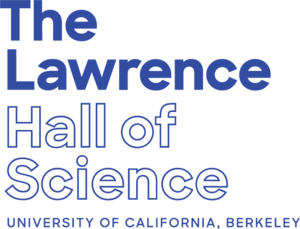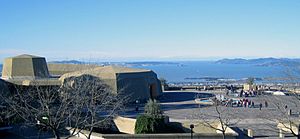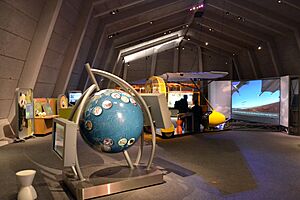Lawrence Hall of Science facts for kids
 |
|
 |
|
| Established | 1968 |
|---|---|
| Location | Berkeley, California, United States |
| Type | Science |
| Public transit access | AC Transit #65 or UC Berkeley Shuttle |
The Lawrence Hall of Science is an exciting public science center located in Berkeley, California. It offers amazing hands-on science exhibits and helps students of all ages learn about science. The Hall also creates learning materials and supports teachers. It opened in 1968 to honor Ernest Orlando Lawrence, a famous physicist. He was the first person from the University of California to win a Nobel Prize. The center sits on a hill above the University of California, Berkeley campus.
Contents
Explore Amazing Science Exhibits
The Lawrence Hall of Science has many cool exhibits that are always there for you to explore.
- Science on a Sphere – Imagine a giant globe that shows real scientific data from Earth! You can see weather patterns, ocean temperatures, and even how climate change affects our planet. It also shows day and night views, and how tsunamis or hurricanes move. Scientists at NOAA created this cool exhibit.
- Forces That Shape the Bay – This outdoor science park helps you understand the powerful forces that created the San Francisco Bay area. You can learn about earthquakes and how they still change the land.
- Sunstones – This is a huge granite sculpture, 18 feet tall, that acts like an astronomical calendar. It was put outside the Hall in 1979. You can use it to see where the sun sets during the solstices and other important sky events.
- Young Explorers Area – This is a fun, hands-on play area designed for younger kids, from kindergarten age and below.
- Ernest O. Lawrence Memorial – Learn all about the life and work of Ernest O. Lawrence, the scientist the Hall is named after. You can watch a film about him and see parts from one of the very first cyclotrons (a type of particle accelerator).
- Insect Zoo – Get up close with fascinating creatures like hermit crabs, Indian walking sticks, a tarantula, and even hissing cockroaches!
- The Animal Discovery Zone – This is where you can learn about different animals. Many classes for students are held here, giving kids a chance to observe and interact with animals.
- Ingenuity Challenges – Each month, there's a new design challenge! This helps kids think like engineers and solve real-world problems.
- Pheena the Fin Whale – Outside on the plaza, you'll find a life-sized model of a young fin whale. It's huge!
- DNA Sculpture – Also on the plaza, there's a giant model of a DNA molecule. It's scaled down 800 million times! This sculpture was designed by Michael Jantzen and installed in 1992.
Exciting Traveling Exhibits
Besides its permanent exhibits, the Lawrence Hall of Science often hosts special traveling exhibits. These exhibits change over time, so there's always something new to see! Some past traveling exhibits have included "Tony Hawk Rad Science," "Dinosaurs Unearthed," "Scream Machines: The Science of Roller Coasters," and "Wild Music: Songs and Sounds of Life."
The Nobel Prize Display
In 2003, after Ernest Lawrence's wife, Molly Lawrence, passed away, her family decided the Lawrence Hall of Science should keep his 1939 Nobel Prize in Physics. The Nobel Prize medal was placed in a special display case in the E.O. Lawrence Memorial room. This room had shown items from his life and work for almost 40 years.
In 2007, the medal went missing from its locked case. The police were called right away and started an investigation. A reward was offered to help find the medal and catch whoever took it. The medal was made of 23-karat gold and was very valuable. Ernest Lawrence's medal was the first Nobel Prize ever given to the University of California and the first won by an American public university. The prize was later found, and a student was arrested. Today, a replica of Ernest Lawrence's Nobel Prize is on display in the museum.
Explore the Universe at the Planetarium
The Lawrence Hall of Science has its own planetarium, which opened in 1973. It's called the Holt Planetarium. The planetarium creates interactive shows that are used there and in other small planetariums around the world.
The Holt Planetarium is famous for getting the audience involved in the shows. This new way of teaching astronomy has changed how many planetariums present the sky to the public. In 2000, a journal called "The Planetarian" even called the Holt Planetarium "The Best Planetarium in the Whole World"!
The planetarium offers live, interactive shows that are about 25 minutes long. They follow the Hall's idea of hands-on science education. For example, during a show, you might help find constellations or search for planets outside our solar system.
Learning Materials and Programs
The Lawrence Hall of Science creates many educational programs and materials. These are used by students and teachers across the country and even around the world. Some of these programs include FOSS (Full Option Science System), GEMS (Great Explorations in Math and Science), and SEPUP (Science Education for Public Understanding Program). New programs are always being developed, like Global Systems Science (GSS) and Hands-On Universe (HOU).
Science Classes and Camps
The Lawrence Hall of Science has a big education department. They offer classes and day camps for kids and families all year long. These classes cover many different subjects, such as biology, chemistry, astronomy, math, robotics, and art. They also have summer camps in various places in California.
In the 1970s and 1980s, the Hall had a special program called The Friday Project (FRID). It gave gifted teenagers free access to computer systems. This was a big deal because most homes didn't have computers back then. To join, you had to propose a project and get accepted. Students could use systems like Hewlett-Packard's 2000B and Control Data Corporation's PLATO. PLATO was an early online system that had things like forums, message boards, and even online games!
Helping Teachers Learn More
The Lawrence Hall of Science also provides many workshops and training opportunities for teachers. This helps teachers learn new ways to teach science. They can also take online courses about the Hall's curriculum.
The Discovery Store
After exploring the exhibits, you can visit the Discovery Store. It sells many fun science and math products for all ages. You can find science kits, educational posters, soft toys, and even astronaut ice cream!
Part of UC Berkeley
The Lawrence Hall of Science is the public science center for the University of California, Berkeley. The staff at the Hall work with university professors to create new exhibits and educational materials for families and teachers. Some exhibits they worked on together include "Big Dinos Return" and "Forces That Shape the Bay."
The Hall in Movies
The Lawrence Hall of Science has even been featured in movies! In the 1970s, several science fiction films used the Hall as a filming location:
- The 1970 movie Colossus: The Forbin Project used the Hall as the fictional Colossus command center.
- Scenes from the 1971 movie THX 1138 were filmed there.
- A quick shot of the Lawrence Hall of Science appears in the opening of the pilot episode of The Bionic Woman (1976).
Images for kids
-
Visitors observe the winter solstice using the Sunstones II
-
The view of the San Francisco Bay from the Lawrence Hall of Science






